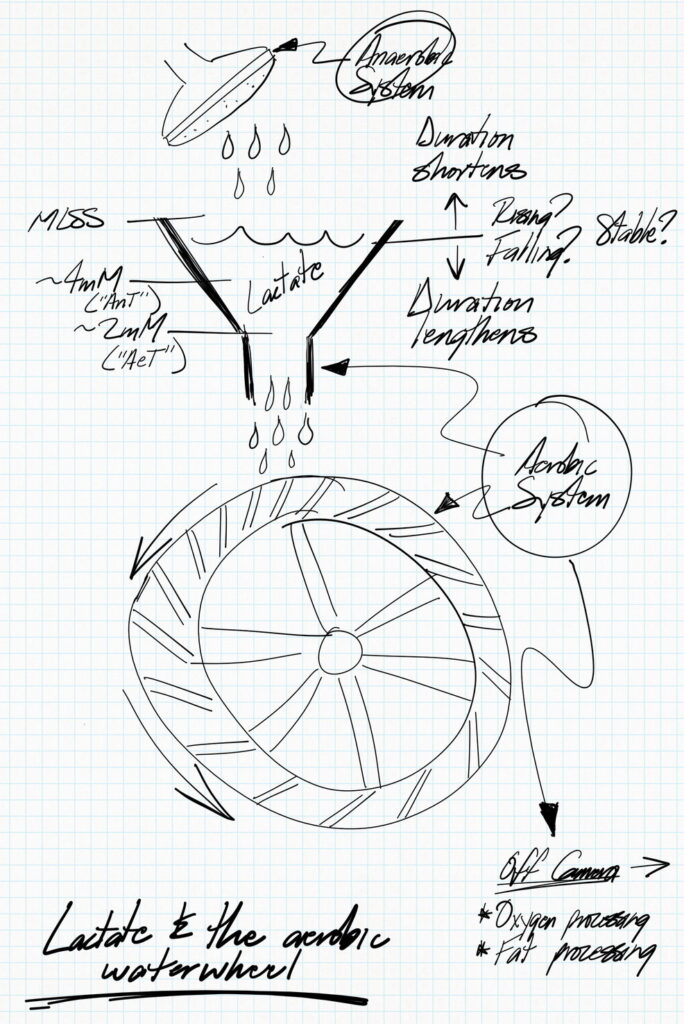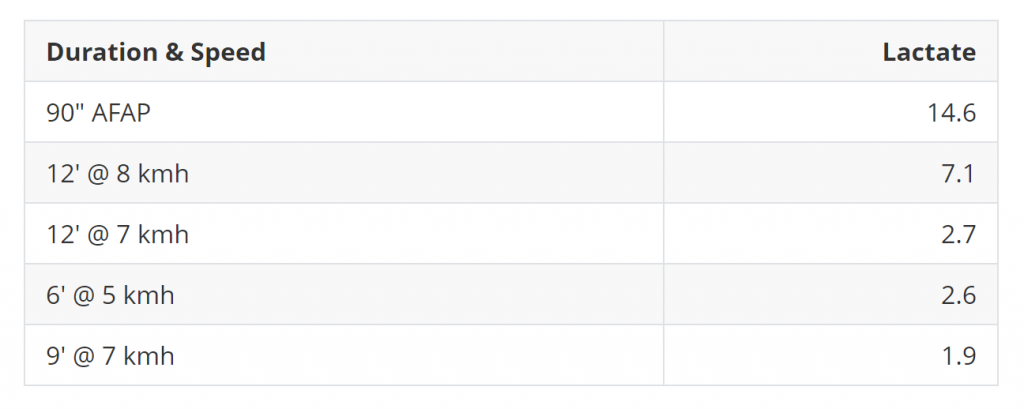When I first started skimo racing, I started races way too fast. The gun would go off, and I’d bolt forward. I’d feel great for about 60 seconds, and then as if I was running through molasses I’d have to slow way down. With that kind of start, the rest of the race felt horrible.
When dug into why this was happening the answer I found ws: “You have insufficient aerobic base.” Said another way; the capacity of my aerobic metabolic system to produce energy to propel me was too low so I was having to rely on the other metabolic pathway, the anaerobic or glycolytic one, to make up the difference in energy. That had the inevitable consequence of slowing me down and making me horrible.
This experience is so common, and not just in competitive athletes, that it is worth asking: What’s going on? Let’s break it down.
What Happens When You Start a Race Too Fast?
By starting too fast:
- I was flooding my muscles with the metabolic by products of that anaerobic energy production—mainly lactate—but also raising the acidity of my blood.
- I was drowning in that metabolic soup, my aerobic system completely overwhelmed. The more acidic my blood, the more I had to slow down to give my aerobic system time to clean things up.
Later I learned that starting much slower allows for a more gradual increase in lactate. Although hard for me to do, starting slower enables a faster average speed. I also learned that to start faster, I need to train my aerobic system to absorb larger amounts of lactate.
When you ramp up too fast, your body recruits fast twitch muscle fibers. Fast twitch muscle fibers run primarily on glycogen, a form of stored sugar (glucose) that is broken down through a process known as glycolysis. This process allow for a faster speed and higher power output, but at a cost.
Glycolysis produces the byproduct lactate which in my case was accumulating at too fast a rate forcing me to slow down. Amazingly, the aerobic metabolic system has the ability to take up and utilize that lactate to produce more energy for the muscles. Imagine a metabolic vacuum cleaner sucking up the lactate. The more capacity that vacuum cleaner has, the faster it can take up that lactate and shuttle it over to muscle fibers that can use it for energy to propel you. Since those fast twitch muscle fibers that I need to propel me at racing speeds are cranking out lactate at a prodigious rate, I need a big aerobic vacuum to deal with it. Bigger vacuum means bigger aerobic base. If I exceed the aerobic capacity of that vacuum by too much, I will have to slow down to allow the vacuum some time to catch up. Often, that clearing process takes so long that your race will be over shortly after it’s begun.
But Why Is It So Slow?
The upper limit of aerobic speeds is generally considered to be an activity level that produces a steady-state blood lactate value around 2 mM/L. Above that, other steady states exist, but the higher levels of lactate reflect a greater and greater contribution from the anaerobic system (glycolysis and fast twitch muscle fibers).
The maximum lactate steady state (MLSS, also known as the Anaerobic Threshold or Lactate Threshold) is the highest speed where the muscles are producing and reabsorbing lactate at equal rates. Above this speed, lactate accumulates in the blood faster than it’s removed. When that starts happening, the clock is ticking. The faster the rate of accumulation, the shorter the duration. At a certain point, the only way the body can restore homeostasis is by slowing things down well below the MLSS.
The frustrating part is that the speed required to reabsorb a large amount of excess lactate is much slower than MLSS. It’s often even much slower than a purely aerobic speed. So if you start a race with a burst, you’ll have to continue at a much slower pace than if you had started without the burst.
Reabsorption speeds are so much slower because even aerobic speeds produce some lactate. If you’re running at your MLSS, your lactate levels will be at a steady state. Lactate is being produced and absorbed at the same rate. There isn’t any available capacity to absorb the excess lactate.

Lactate is a fuel for the aerobic system. The more lactic throughput capacity the aerobic system has—i.e., the bigger the funnel—the higher levels of lactate it can use, and the more anaerobic input it can tolerate. The end result is a faster overall speed.
So your body forces you to slow down. The large gap created between MLSS and the slower speed creates excess capacity. Your muscles can then start reabsorbing excess lactate.
How Long Does It Take to Reabsorb Lactate?
This will vary by athlete, but here’s an example.
The other day I did an anaerobic capacity test to help me plan for this year’s training. Specific to my sport, I set my treadmill to a grade of 25 percent and selected a speed that I thought I could hold for 45–90 seconds. The goal was to produce as much lactate as possible, so I needed a short, maximal effort.
Once the test was over, I lowered the treadmill to 1 percent and ran slowly. I measured my lactate after several long intervals. Here are the results (note: AFAP = As Fast as Possible):

My Aerobic Threshold (~2 mM) for flat running is a blistering 11 kmh (a little more than half the ~2 mM speed of a professional marathoner... ouch).
Normally, running at 7 kilometers per hour, my lactate values would be much lower than 1.9 mM. You can see that I had to go way below my Aerobic Threshold to restore aerobic levels of lactate.
As described above, the reasons for this are several:
- Any activity level produces some lactate. If the blood is already saturated, even speeds at MLSS/Anaerobic Threshold are too fast to reabsorb excess lactate. I needed to slow considerably to see significant lactate clearance.
- To speed the clearing process, extremely slow speeds are required. So in a race context, if you start too fast, your average speed for the event will be much slower. If you start without the burst, you avoid the initial flood of lactate and the slow reabsorption period.
- Frustrated by the slow speed on race day, most people misunderstand the problem. They won’t go slow enough to correct it, which prolongs the problem and makes their race even worse. Their mistaken take away is that their ANaerobic capacity is too low and they need more intensity in their program when just the opposite is true and they need more AEROBIC capacity, or a bigger aerobic base.
You’ll notice that my second-to-last interval was at 5 kilometers per hour, but very little lactate was reabsorbed. The change from the previous interval was only 0.1 mM.
My first guess is that the speed was too slow for optimal reabsorption. There wasn’t enough muscle fiber recruitment to maximize the lactate recycling. Or I needed more time to get down to aerobic levels. I’ll have to wait for future tests to find out.
But How Can So-and-So Start So Fast?
Some athletes are fast starters. They can burst off the line at close to race pace and maintain a high speed for the duration of the race.
My hypothesis is that:
- These fast starters are very slow twitch and don’t produce much lactate; or
- They have very large “funnels” (aerobic bases); or
- Both.
For athletes that are very slow twitch, their anaerobic capacity is naturally low. They can start at a high speed without overwhelming their aerobic system. For a pure slow twitcher, it makes sense to use that advantage at the beginning of a race.
The disadvantage of a slow twitcher is that they typically don’t have as much “kick” at the end of a race.

Different aerobic bases visualized as funnels
In contrast, fast twitchers need to start slower and ramp up to race pace. “Slower” won’t feel slow; it just has to be slow enough not to overwhelm the aerobic system.
The high anaerobic capacity of a fast twitcher is also an advantage, but only at the end of a race. In the beginning, it’s a liability.
This article was originally published by Scott Semple.

